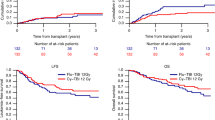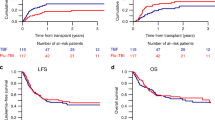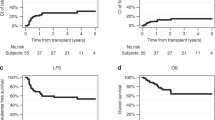Abstract
We investigated an intensified conditioning regimen including fractionated total body irradiation (12 Gy), etoposide (30–45 mg/kg) and cyclophosphamide (120 mg/kg), followed by autologous (n = 5), allo-related (n = 13) or allo-unrelated (n = 6) bone marrow (n = 22) or peripheral stem cell (n = 2) transplantation in patients with Philadelphia chromosome-positive acute lymphoblastic leukemia. One patient received busulfan (16 mg/kg) instead of TBI. Nineteen patients were transplanted in 1CR, two in 2CR, one in 1PR and two in relapse. Major toxicity was mucositis grade II according to the Bearman scale in all patients. The treatment-related mortality was 25%, mainly due to infection or GVHD after allogeneic transplantation. After a median follow-up of 45 months (range 2–93), nine patients (37.5%) remain alive in CR. Nine patients (37.5%) relapsed and eight (33.3%) of these subsequently died. After autologous transplantation, four of five patients (80%) relapsed and died. Late relapse was seen after allogeneic, as well as autologous transplantation, at 33 and 59 months, respectively. The Kaplan–Meier estimate of leukemia-free survival for all patients is 38% at 3 years (95% CI: 18–58%) and 35% at 5 years (95% CI: 15–55%). For allogeneic transplants in first CR (n = 15) the estimate of disease-free survival was 46% at 3 years (95% CI: 19–73%) and 34% at 5 years (95% CI: 17–51%). Patients aged below 30 years had a better estimated overall survival at 3 years (61% vs 11%, P < 0.001). the bcr-abl fusion transcript (p210 vs p190 vs p210/190) did not affect disease-free or overall survival. In our experience, an intensified conditioning regimen seems to improve the results of bone marrow transplantation in patients with Ph+ acute lymphoblastic leukemia. However, the high relapse rate warrants novel approaches to enhance anti-leukemic efficacy.
This is a preview of subscription content, access via your institution
Access options
Subscribe to this journal
Receive 12 print issues and online access
$259.00 per year
only $21.58 per issue
Buy this article
- Purchase on Springer Link
- Instant access to full article PDF
Prices may be subject to local taxes which are calculated during checkout
Similar content being viewed by others
Author information
Authors and Affiliations
Rights and permissions
About this article
Cite this article
Kröger, N., Krüger, W., Wacker-Backhaus, G. et al. Intensified conditioning regimen in bone marrow transplantation for Philadelphia chromosome-positive acute lymphoblastic leukemia. Bone Marrow Transplant 22, 1029–1033 (1998). https://doi.org/10.1038/sj.bmt.1701498
Received:
Accepted:
Published:
Issue Date:
DOI: https://doi.org/10.1038/sj.bmt.1701498
Keywords
This article is cited by
-
Comparable results in patients with acute lymphoblastic leukemia after related and unrelated stem cell transplantation
Bone Marrow Transplantation (2006)
-
Significant reduction of the hybrid BCR/ABL transcripts after induction and consolidation therapy is a powerful predictor of treatment response in adult Philadelphia-positive acute lymphoblastic leukemia
Leukemia (2005)
-
Allogeneic bone marrow transplantation vs chemotherapy for children with Philadelphia chromosome-positive acute lymphoblastic leukemia
Bone Marrow Transplantation (2004)
-
A potential graft-versus-leukemia effect after allogeneic hematopoietic stem cell transplantation for patients with Philadelphia chromosome-positive acute lymphoblastic leukemia: results from the French Bone Marrow Transplantation Society
Bone Marrow Transplantation (2003)
-
Imatinib mesylate (STI571) in preparation for allogeneic hematopoietic stem cell transplantation and donor lymphocyte infusions in patients with Philadelphia-positive acute leukemias
Leukemia (2003)



